Mastering the Use of Refractometers for Precision Measurements


Intro
Refractometers are fascinating devices that play a crucial role in various scientific fields. They measure the way light bends, or refracts, as it passes through a liquid. This seemingly simple principle holds immense significance, from everyday applications like checking the sugar content in beverages to specialized uses in gemology. Understanding refractometers can enhance proficiency, whether you are a hobbyist or a seasoned professional.
The utility of a refractometer can’t be overstated. With the ability to deliver precise measurements, these instruments are invaluable in laboratories, food production, and even in geological studies. The purpose of this article is to arm both enthusiasts and experts with comprehensive knowledge regarding refractometry. We’ll explore its history, operational techniques, calibration methods, and practical applications in various domains. Moreover, we will shine a light on the benefits and best practices necessary for accurate measurements. So, let’s dive in!
History and Origins
The journey of the refractometer is as intriguing as the device itself. Though the concept of measuring light refraction goes back centuries, the first true refractometer was built in the late 19th century. The idea stemmed from earlier optical devices that recorded light behavior but didn’t provide a precise scale for measurement.
Early inventors aimed to utilize the phenomenon of light refraction—where light changes direction as it transitions between different mediums. Light bending when entering a liquid was first documented in the work of ancient philosophers. However, the practical application didn't emerge until scientists began exploring its relevance in analytical chemistry.
By the time the 1930s rolled around, Heinrich Abbe introduced a more sophisticated design, incorporating a scale for direct reading. This innovation laid the groundwork for modern refractometers.
"The refractometer has evolved from a mere curiosity into an essential tool in science and industry alike."
Historical Significance and Cultural Impact
In the realm of the sciences, the refractometer opened new doors to understanding various liquid properties. As industries grew, especially in food and beverage, the demand for consistent quality control soared. Rather than relying on inconsistent methods or unproven techniques, businesses shifted toward using refractometers for quality assurance in liquid products. This change not only increased the reliability of results but also revolutionized several sectors, including wine-making and brewing.
In gemology, the refractometer became a secret weapon for jewelers, allowing them to identify gems more precisely by measuring their refractive index, thus steering buyers toward authenticity rather than facsimile.
As refractometers found a home in the toolbox of numerous professionals, their global influence became undeniable. They made their mark not just in laboratories but also in schools and universities, enhancing the educational experience for budding scientists.
Understanding the historical context of refractometers enriches our appreciation of their current applications. As we delve deeper into their functions and uses, the legacy of innovation remains a driving force in the evolution of this remarkable instrument.
Identification and Classification
The identification and classification of refractometers depend on several factors, including design, use cases, and operational technology. Generally, these instruments can be divided into a few broad categories.
Guide to Identifying Refractometers
- Analog vs. Digital: Analog refractometers typically feature a manual scale for reading, while digital ones display results electronically, offering higher precision and ease of use.
- Abbe Refractometers: Often used in labs, they are known for their accuracy and reliability, particularly in measuring the refractive index of small liquid samples.
- Handheld Refractometers: Perfect for fieldwork, these compact instruments are user-friendly and portable, commonly used in a variety of industries such as agriculture and food testing.
- Brix Refractometers: Specialized for measuring sugar content, particularly in liquids like fruit juice or honey; these are popular among food producers.
- Gem Refractometers: Designed specifically for gemology, they measure the refractive index of gemstones, crucial for identifying and classifying them.
Common Types and Variations
A closer look at refractometers reveals several variations catering to specific needs:
- Optical Refractometers: Use light to measure index of refraction.
- Thermal Refractometers: Adjust readings based on temperature variations.
- Inline Refractometers: Installed directly in production lines to constantly measure parameters in real-time.
Understanding these distinctions aids users in selecting the proper refractometer tailored to their specific needs, ensuring accuracy and efficiency in their work.
Overall, the refractometer has come a long way from its rudimentary beginnings. With a deep-rooted history and varied classifications, its relevance across multiple fields persists, signifying its essential role in modern scientific endeavors.
Prelude to Refractometry
Refractometry plays a vital role in understanding the interaction of light with various liquids. It measures how light changes direction when it passes through different mediums, which is essential in fields from food science to gemology. By utilizing a refractometer, one can quantify the concentration of solutions with precision, lending itself to both professional and recreational pursuits.
Understanding Basic Concepts
At its core, refractometry hinges on a straightforward principle: the refraction of light. When light travels from one medium to another—say, from air into water—it slows down and bends. This bending, quantified by the refractive index, is what refractometers measure. The refractive index is a dimensionless number, essentially a ratio that compares the speed of light in a vacuum to the speed of light in a particular substance. With a refractometer, this index offers significant insights into the sample's composition, be it sugar content in a syrup or the concentration of a saline solution.
It's essential to note that different substances will exhibit varying refractive indices. For example, pure water has a refractive index of about 1.333, while saline solutions can present higher indices depending on their concentration. This characteristic makes refractometers incredibly valuable for diverse industries, allowing users to make informed decisions based on empirical data.
Historical Context
Refractometry is not a recent development. Its roots stretch back to the early days of optics. The first known work on light refraction was done by the ancient Greeks, who observed the bending of light but lacked the tools for precise measurement. Fast forward to the 17th century, and we see the introduction of the first practical refractometer by Willebrord Snellius (commonly known as Snell) and later refined by various scientists.
In the early 20th century, refractometers evolved into sophisticated instruments widely used across laboratories and industries. This period also witnessed the rise of gemology as a scientific field, where refractometry became indispensable in identifying gemstones based on their unique optical characteristics. The historical significance of refractometry underscores its long-standing importance in enhancing our understanding of material properties, establishing it as a cornerstone in both applied science and commercial endeavors.
This exploration of refractometry sets the stage for understanding its types, uses, and applications in more detail throughout this Comprehensive Guide.
Types of Refractometers
Understanding the different types of refractometers is crucial for anyone interested in accurately measuring specific gravity in liquids. Each type has unique features, benefits, and ideal use cases, which means choosing the right one can greatly influence the quality and precision of your measurements. As we delve into this section, keep in mind that your specific needs often outline your choice of refractometer. Whether you’re in gemology, food science, or simply a hobbyist looking to explore the fascinating world of light refraction, knowing the characteristics of each type is essential.
Analog Refractometers
Analog refractometers offer a straightforward, classic method for measuring liquid refractive indices. They utilize a glass prism and a light source to project the line of demarcation between light refracted through the sample and another control liquid.
One key aspect of analog models is their durability; they usually require minimal maintenance and can be quite resilient to rough handling. These units are less expensive compared to their digital counterparts, making them an attractive option for those who want quality without breaking the bank. However, take note that reading the measurement scale can be tricky if the lighting isn't just right. In dim light, you might find yourself squinting like a hawk as you try to get an accurate reading, which necessitates experience and practice to master.
Digital Refractometers
Entering the realm of digital refractometers, we encounter devices that have evolved to simplify and enhance the user experience. Unlike their analog cousins, digital models present an electronic display that eliminates the guesswork associated with reading scales. A digital refractometer uses advanced optical systems and sensors to provide precise readings, often capable of capturing minute changes in refractive index.
These devices are particularly beneficial in settings where repeated measurements are necessary, like laboratories or production lines. Their convenience aligns well with modern efficiency in workflows. However, they do bring a higher price point and sometimes require batteries, creating potential for technical complications that, while rare, aren’t necessarily eliminated.
Abbe Refractometers
If you're serious about your work—say, as a professional gemologist or a researcher—an Abbe refractometer might just be your best friend. Designed for laboratory use, this type boasts an adjustable light source and a more sophisticated optical design allowing for exceptional accuracy. Unlike the simpler analog models, Abbe refractometers enable precise temperature control, which is essential since temperature can greatly affect the refractive index of liquids.
The hallmark of these kits is their ability to measure not just liquids but also solids and gels, broadening their application range. Although they are often more expensive and bulky—making portability challenging—the high level of precision is generally worth the investment for professionals who demand accuracy.
Handheld Refractometers
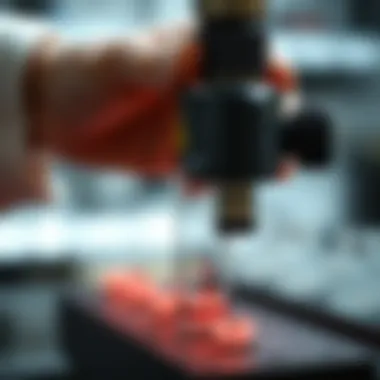
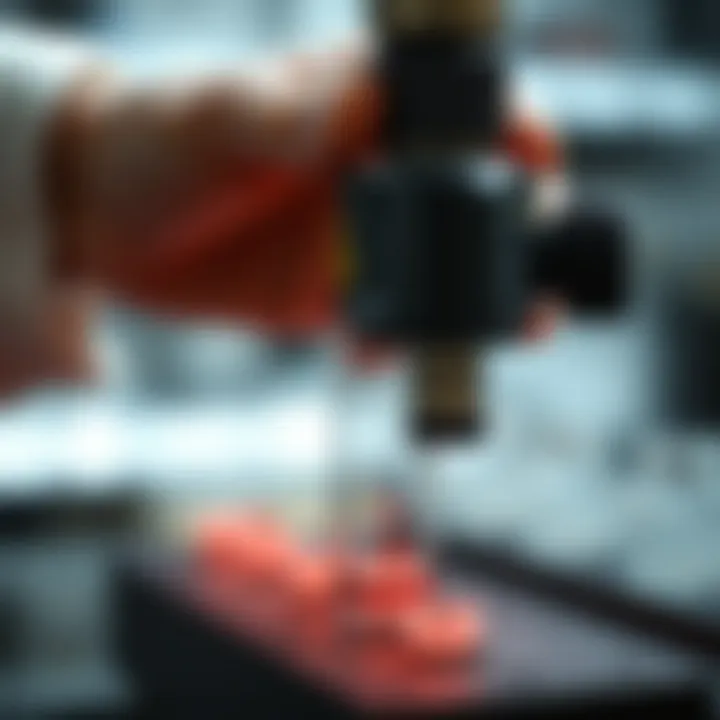
Handheld refractometers can be a game-changer for individuals on the move; they're compact, lightweight, and often pocket-sized. These small yet powerful tools provide excellent versatility, making them suitable for quick readings in various fields—whether you’re out in the field, checking wine profiles, or testing the salinity of seawater.
Overall, handy models can get you results fairly rapid, often requiring just a drop or two of your sample. However, their ease of use may sacrifice some level of accuracy when compared to larger, more complex devices. It's fine for casual use but can lead to discrepancies in environments where precision is paramount.
Ultimately, choosing the right refractometer depends on many factors: your specific application, budget, and the level of accuracy you need. With a bit of research and insight into each type’s capabilities, you'll be well-equipped to select the refractometer that best suits your needs.
Components of a Refractometer
Understanding the components of a refractometer is pivotal for anyone looking to master its use. Each element plays an integral role in the device's overall function, influencing the accuracy of measurements and the quality of insights drawn from liquid samples. Let's break down the core components that make a refractometer not just useful, but essential in fields like gemology, brewing, and even culinary arts.
Optical Prism
The optical prism is arguably the heart of a refractometer. It is crafted to bend light in a precise manner, allowing the device to measure the refractive index of a liquid sample. Think of the prism as a door that opens up a whole new world of insight. When a sample is placed on the prism, the light passing through is bent based on the liquid's composition. This interaction is what allows users to observe the refraction angle, which directly correlates to the liquid's concentration.
What makes the optical prism significant is its sensitivity. Many prisms are made from high-quality glass or quartz, ensuring that they are durable and can withstand repeated use. However, care must be taken to keep the prism clean, as any residue or smudges can lead to inaccurate readings. To put it another way, a dirty prism is like trying to read a book with smudged pages—nothing makes sense.
Light Source
Next up is the light source, an often overlooked component that carries substantial weight in the measurement process. In many refractometers, this is typically provided by LED lights, but sometimes, a simple halogen bulb can be used. The light source illuminates the sample placed on the prism, enabling the user to see the critical angles and therefore determine the refractive index more accurately.
Without an appropriate light source, measurements can veer dangerously off course. For example, if the light is too dim, the user might misinterpret the angle of refraction, leading to erroneous conclusions about the sample's composition. Essentially, the light source provides the illumination necessary to bridge the gap between data collection and analysis.
Measurement Scale
Finally, we have the measurement scale, the interface through which the user engages with the refractometer's findings. This scale could be analog or digital, depending on the model, and it provides critical information that helps users relate the refraction angle to specific measurements—like Brix for sugars or specific gravity for other liquids.
With analog models, users must rely on a calibrated scale marked directly on the device, which can be a bit tricky at times due to potential parallax errors. On the other hand, digital refractometers display the readings on a screen, often with built-in features for converting units or averaging multiple readings.
As such, a well-calibrated measurement scale is what allows any readings to hold true value. Take the time to familiarize yourself with whichever model you choose; it could save you a lot of guessing work down the line.
In summary, each component of a refractometer—optical prism, light source, and measurement scale—works in concert to provide reliable readings. Understanding how these elements interact elevates your ability to use the refractometer effectively, whether you're checking the sugar content of your homemade jam or assessing the quality of a gemstone. By paying close attention to these details, you're not just using a device; you're gaining deeper insights into the liquids around you.
Preparing to Use a Refractometer
Preparing to use a refractometer involves several critical steps that ensure accurate and reliable readings. This preparation phase is foundational for getting the most out of the device. Each component from selection to calibration must be carefully considered to achieve precision in measurements. Neglecting these preparatory steps may lead to erroneous results, affecting analysis or experiments. Thus, understanding how to properly get set before diving into measurement is of utmost importance.
Choosing the Right Model
The first step in preparing to use a refractometer is selecting the right model for your specific needs. Not every refractometer suits every application, so understanding the differences among them is critical. For instance, if you work primarily with liquids with low sugar content, a Brix refractometer might serve you well. Conversely, if you’re in gemology, a specific gem refractometer would be your best choice.
When selecting, consider:
- Purpose: What kind of liquid or solution are you measuring?
- Accuracy requirements: Higher precision models are available for critical measurements.
- Portability: Will you be using it in the lab only, or do you need something more field-friendly?
By choosing the right model, you set the stage for successful refractometry.
Cleaning the Device
Before utilizing your refractometer, ensuring that it is clean is crucial. A messy prism can give skewed readings and potentially ruin your samples. Cleaning is quite straightforward, but it does demand attention to detail. Usually, a soft, lint-free cloth and some distilled water do the trick.
- Why distilled water? Using distilled water avoids the possibility of any contaminants affecting your readings.
- Regular maintenance: Consistent cleaning after each use will prolong the life and accuracy of your device.
Keeping your refractometer clean is as important as having a good model; it helps avoid unnecessary headaches in the long run.
Calibrating the Refractometer
Calibrating a refractometer is the cornerstone of accurate readings. Calibration corrects any deviation that might exist in the readings, ensuring reliability. It’s a task that ideally should be performed regularly, especially if the device has been stored for a while or has experienced shifts in temperature.
Using Distilled Water
When calibrating, using distilled water is often the go-to method. This is largely because distilled water has a well-known refractive index of 1.333, which serves as a standard reference point for most refractometers.
- Key Characteristics: Its purity ensures that there are no unknown compounds skewing the results. This makes distilled water a reliable choice in scientific measurements.
- Benefits: It’s readily available, relatively inexpensive, and simplifies the calibration process. The unique feature of distilled water in this context is its predictability, allowing operators to be confident in their calibration process.
However, you must always take care that the prism is clean before using distilled water for calibration.
Adjusting for Temperature
Temperature can significantly impact reading accuracy. Most refractometers will specify an optimal temperature range for use; adjusting for temperature thus becomes essential in achieving reliable results.
- Key Characteristic: Different liquids have varying refractive indices at different temperatures. Without proper adjustment, the reading can vary significantly, affecting the outcome of your measurements.
- Benefits: Taking temperature into account helps increase the accuracy of your readings no matter the environment. Its unique feature lies in recalibrating the device according to the temperature of the sample, which ensures that you are always working with accurate data.
In practice, employing temperature correction might seem tedious, but it’s a small price to pay for enhanced accuracy and can really affect how applicable your readings are in real-world scenarios.
How to Use a Refractometer
Understanding how to properly utilize a refractometer is vital for obtaining accurate measurements in any field that relies on liquid analysis. Whether you're measuring the sugar content in your homemade jams or assessing the purity of a solution in a laboratory, the ability to correctly operate this device can make all the difference. The key elements in this process include how you place your sample, how to take the reading accurately, and what calculations need to be performed for various concentrations. Mastering these elements ensures reliable results, which is crucial for both scientific and practical applications.
Placing the Sample
When it comes to using a refractometer, the way you place your sample can significantly impact the measurement results. First off, it is crucial that the sample is fresh and free from any particulates. Before placing it on the prism, a quick check for any bubbles or contaminants is wise. The goal is to have a clean, smooth sample that fills the sample well without overflowing, leading to contamination of readings.
To place the sample:
- Open the cover: Most refractometers have a protective cover to keep the prism clean. Open it gently.
- Apply a small drop of liquid: Use a pipette or a dropper to add a small amount of your sample to the prism. The volume should not exceed a few drops—more can lead to inaccurate readings.
- Close the cover: Gently close the cover to spread the liquid evenly across the prism. A good seal is necessary to eliminate air pockets that could skew the results.
This process may seem straightforward, but ensuring that you have a precise application of the sample will yield far better results. It's often the small details that make the largest impact on the outcome.
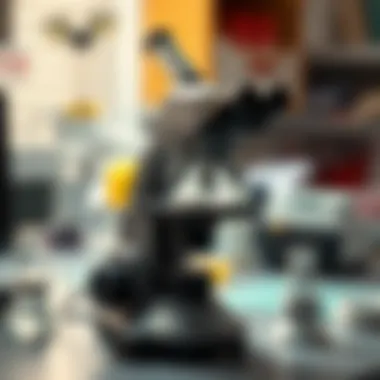
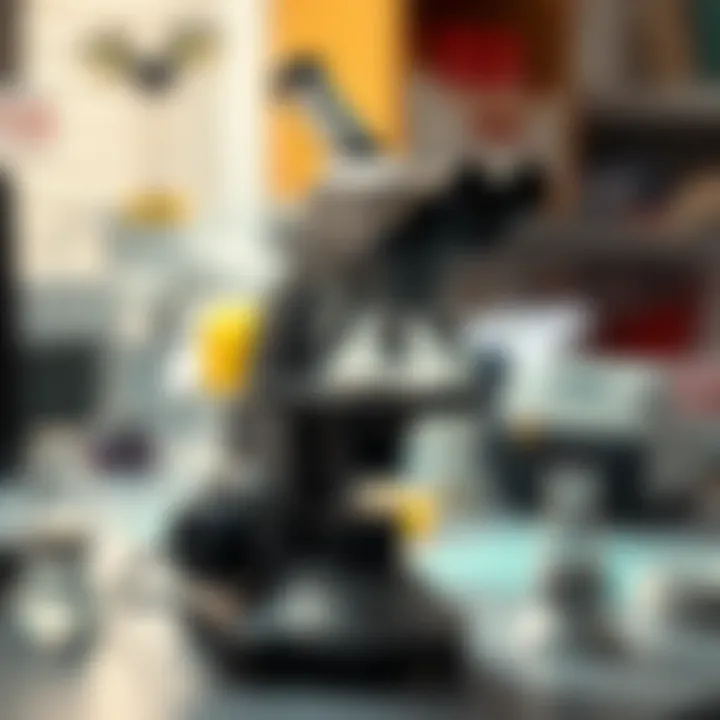
Taking the Reading
Once your sample is properly placed and the cover is closed, you can move on to taking the actual reading. Make sure you give the light source, usually a small LED or halogen bulb, ample time to illuminate the sample.
To take the reading:
- Look through the eyepiece: Position your eye at the eyepiece and adjust it for a clear view. You should see a distinct boundary line separating light and dark areas, which is crucial for determining the measurement.
- Find the scale: Locate the specific scale you’re interested in, such as the Brix scale for sugar content or another relevant measurement depending on your field.
- Record the value: Note the point where the boundary line intersects the scale. This intersection gives you the refractive index of your sample, which is essential for your calculations.
It’s important to remember that taking multiple readings can help ensure accuracy and detect any anomalies. If the readings vary significantly, consider reassessing the sample or the device itself for faults.
Multiplying for Concentration
After you’ve taken your reading, the next step often involves determining the concentration of the solution. This can be particularly important in many applications, like in food production or gemstone assessment, where precise concentration values are invaluable.
To multiply for concentration:
- Identify the reading: Referring back to your previous step, you’ll want the measured value from your refractometer reading.
- Consult tables (if necessary): Depending on what you've measured, you might need to refer to conversion charts to determine how that reading translates into concentration. For example, if you've measured in the Brix scale, you may want to express this as grams of sugar per gallon.
- Perform the multiplication: Multiply the reading you've obtained against any necessary conversion factors to reach a final value. For instance, if you measure a Brix of 20, you may calculate that yields about 200 grams of sugar per liter.
This step is imperative as it allows you to interpret your findings accurately, ensuring you can convey the right information based on your findings and contribute effectively in your respective area, whether it's culinary, gemological, or any other relevant field.
"The art of measurement lies not just in knowing how to take the reading, but in understanding what the reading actually means in practical terms."
By following these steps carefully, you can ensure that your use of a refractometer is efficient and effective, leading to reliable measurements that will inform your work and improve your outcomes.
Interpreting Refractometer Readings
Interpreting readings from a refractometer isn't just a matter of looking at numbers; it’s about understanding what those numbers signify in a broader context. This is crucial because accurate measurement underpins any scientific inquiry or practical application. For those engaged in fields like gemology, food science, or chemical analysis, this knowledge can mean the difference between yielding actionable insights and drawing misleading conclusions.
Understanding Brix Scale
Brix is a term that will come up frequently, especially in culinary and beverage industries. The Brix scale measures the sugar content in a liquid solution. Specifically, one degree Brix is equal to 1 gram of sucrose in 100 grams of solution. This scale helps various professionals, particularly in winemaking and fruit juice production, assess sweetness and sugar levels effectively.
For example, when measuring the Brix of grape juice, winemakers can determine timing for harvest or whether additional sugar should be added during fermentation. A reading of 20° Brix would indicate a relatively sweet juice, potentially leading to a rich wine, whereas something around 10° would signal a more acidic flavor profile. Monitoring these levels consistently allows producers to maintain quality across batches.
Determining Sugar Content
When it comes to determining sugar content, a refractometer can provide real-time data swiftly. After placing a drop of your sample onto the prism and obtaining a reading, it’s vital to convert that number into actionable insights—what does that “Brix” reading tell you?
In many food applications, such as making jams or syrups, sugar content directly influences texture and consistency. If your reading shows a sugar concentration too high or too low, adjustments need to be made early in the process to avoid unfavorable results. Also, consider that some ingredients, like tart fruits, can artificially inflate sugar readings. In such cases, additional methods, perhaps relying on titration or using a hydrometer, might complement refractometric values for thorough accuracy.
Interpreting Various Scales
In addition to the Brix scale, refractometers can measure a range of other scales pertinent to various industries. For example, a refractometer in a laboratory setting could also be used to measure the refractive index of a liquid which is invaluable for chemists and scientists. Understanding different scales enables one to adapt results towards specific fields effectively.
Some other scales exist, such as the Salinity scale, useful for marine biologists and aquarists to monitor salt concentration in water, or the Alcohol Proof scale, which can guide brewers in assessing their product's potency.
Creating a comprehensive picture involves dropping into your readings and understanding the relationships between these different variables. It is no longer just about numbers; it's about the context, the application, and the results.
"In science and business alike, often the smallest variable can yield the most significant outcome. So, interpreting your readings correctly is critical."
For further reading and resources, check out
Wikipedia on Refractometry
or
Beverage Quality Insights.
By integrating this understanding into your work, whether you’re a rock collector checking the refractive indices of minerals like quartz, or a professional in winemaking, you'll find your expertise and results will markedly improve.
Applications of Refractometry
Refractometry serves as a versatile tool across numerous industries, making it indispensable for anyone who requires precise measurements of liquid characteristics. Understanding how refractometers are utilized can empower professionals and enthusiasts alike, enriching their practices and enhancing the accuracy of their results. Each application underscores the utility of refractometry while revealing the intricate interplay between light and liquid.
In the Food Industry
In the food industry, refractometers play a significant role in ensuring the quality and consistency of products. For instance, they are crucial in gauging sugar concentration in syrups, jams, and jellies. Imagine the difference between a perfectly balanced fruit preserve and one that turns out too sweet or feeling like a toothache. Using a refractometer ensures that manufacturers can maintain a uniform sugar level, achieving the desirable texture and taste.
Moreover, refractometers are used to monitor the sugar content in fruits during processing. Various fruits have different Brix levels, and knowing these can dictate how the final product will taste. This application isn’t just beneficial for large manufacturers; even small-time jam makers operating from home can use a refractometer to elevate their products’ quality.
In the Beverage Sector
The beverage sector, particularly in the production of juices, wines, and beers, leverages refractometers extensively. Here, they assist in evaluating the quality of batches and ensuring a predictable flavor profile. For example, when brewing beer, brewers can routinely check the original gravity using a refractometer, which determines the amount of fermentable sugars present.
The Brix level of juices is another area where refractometers confuse the competitors. Monitoring sugar concentrations in fruit juices not only affects the taste but also impacts marketability and pricing. Precise refractometry ensures that beverages taste their best at the point of purchase, satisfying consumers and maintaining brand loyalty.
In Gemology
Gemologists employ refractometry as a fundamental technique to identify gemstones. Each type of gemstone exhibits unique refractive indices, making it easier to distinguish between similar-looking stones. For gem enthusiasts and collectors, understanding these differences can be key to categorizing stones accurately.
Using a refractometer in gemology requires precision and a steady hand but pays off by providing valuable data about each specimen. A slight variation in refraction can signal a higher or lower value; thus, for a collector, having access to a refractometer can enhance one’s expertise and potentially lead to better purchasing decisions.
In Chemical Analysis
In the realm of chemical analysis, refractometers are essential for determining the concentration of various solutions. Whether it’s for laboratory work or industrial processes, accurately measuring concentrations can be critical in ensuring reactions occur as intended. Refining fuels, for instance, requires precise knowledge of hydrocarbon concentrations, something a refractometer can measure effectively.
Additionally, in pharmaceutical tasks, where every compound's concentration is crucial to a medicine's efficacy, refractometry proves vital. By providing a reliable method for measuring concentration, refractometers help avoid mishaps that could arise from improper mixture ratios.
Refractometry is more than just a measurement technique; it's a critical ally in creating products that meet stringent quality standards across multiple fields.
Refractometry's applications across various industries illustrate its importance and versatility. Whether maintaining the harmony of a recipe or ensuring the integrity of precious gems, refractometers provide essential insights. Engaging in their use can elevate one’s work, marry science with art, and yield results that meet or exceed expectations.
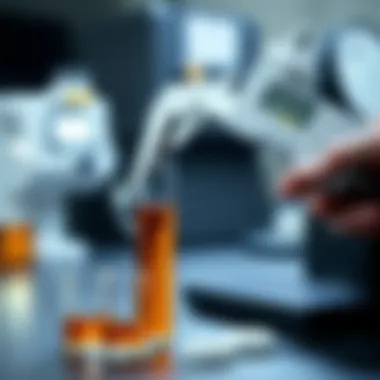
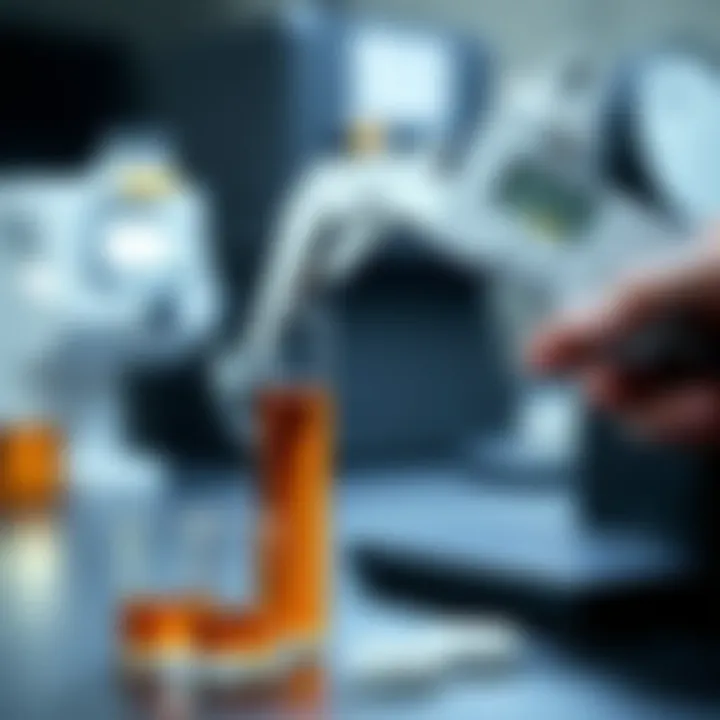
Troubleshooting Common Issues
Using a refractometer can be a straightforward process, but even the best tools run into hiccups now and then. Knowing how to troubleshoot common issues ensures that your readings remain accurate and reliable. This section provides the insights you need to identify and resolve problems, ultimately enhancing your ability to measure liquid properties effectively.
Inaccurate Readings
One of the most frustrating problems with refractometers is when they deliver inaccurate readings. This can lead to misinterpretations in your work, be it in gemology or the food and beverage industry. The reasons behind these inaccuracies can be varied. For example:
- Calibration Issues: If your refractometer isn’t calibrated properly, it won't give you the right numbers. Calibration should ideally be done with distilled water at a standardized temperature to ensure measurements are precise.
- Sample Contamination: Any residue from previous readings can skew your results. Make sure you clean the prism thoroughly after each use. Even a drop of oil can throw off the refractive index significantly.
In short, when dealing with inaccurate readings, always start with a re-check on calibration and sample purity.
Dirty Prism
The prism is the heart of the refractometer, and if it’s dirty, you might as well throw the thing out the window. Dust, fingerprints, or any liquid residue can cloud your measurements. To prevent this:
- Regular Cleaning: Use a soft, lint-free cloth to wipe the prism before and after each measurement. Avoid any harsh chemicals that might scratch the surface.
- Use Distilled Water: When cleaning, distilled water is your friend. It prevents mineral buildup that can occur with tap water.
Keeping the prism clean will not only give you better readings but also extend the lifespan of your device.
Temperature Fluctuations
Temperature plays a critical role in refractometry. Variations in temperature can affect both the liquid you are measuring and the refractometer itself. If you're in an environment where temperatures swing dramatically, be aware:
- Temperature Compensation: Some digital refractometers come equipped with temperature compensation features. This is essential if you’re working in non-stable environments.
- Allowing Equipment to Adjust: Before taking measurements, let your refractometer acclimatize to the ambient temperature for at least 15 minutes. This reduces the chance of erroneous readings due to thermal shock.
Recognizing these fluctuations and adapting your technique can bolster your accuracy significantly.
"In the realm of refractometry, attention to detail is paramount. A clean prism and proper temperature settings can make or break your results."
Understanding these common pitfalls will prepare you for successful refractometer usage in your field, whether you’re soaring high with gemstones or diving deep into liquids.
Best Practices for Accurate Measurements
When it comes to utilizing a refractometer, precise measurements are the bread and butter of effective analysis. Whether you're measuring sugar levels in beverages, checking the purity of gemstones, or analyzing chemical solutions, following established protocols for accuracy is crucial. Neglecting best practices can lead to results that are not only misleading but could also skew further analysis and decisions. Here, we outline key methodologies to ensure that your measurements stand the test of scrutiny.
Consistent Sample Size
A consistent sample size is vital when taking readings with a refractometer. Each sample should be as uniform as possible to minimize variations in refractive index caused by changes in composition or concentration. If you’re examining three different samples, for instance, using 5 milliliters for each will yield more reliable comparisons than mixing up the sample quantities.
- Aim for a standard volume each time.
- Keep your sample's physical state constant, be it liquid, gel, or solid solution.
- Avoid using the refractometer on samples that are too viscous or too frothy at the risk of interpreting bubbles as misleading readings.
"The devil is in the details — in refractometry, even the tiniest inconsistencies can lead to significant errors."
Controlling Environmental Factors
Environmental factors can significantly impact the accuracy of readings. Ambient temperature and light can affect how light refracts through the sample being tested. To achieve optimal results, it’s beneficial to take several aspects into account:
- Temperature: Conduct tests in a stable environment. Sudden changes in temperature can alter refractive readings, so ensure both the sample and device are acclimatized to the same temperature before taking readings.
- Lighting: Insufficient lighting might hinder visualization on the scale if it's a manually operated model. On the contrary, excessive light can cause glare, leading to misinterpretations. Use diffused lighting where possible to provide consistent conditions.
- Air Quality: Dust and particulates can alter measurements. Conduct tests in a clean environment to eliminate dust that might interfere with your samples.
Regular Calibration
Calibrating your refractometer should not be an afterthought; it’s a cornerstone of reliable measurements. Regular calibration sets a benchmark for accuracy and helps in identifying any drift in measurements over time.
- Using Distilled Water: One of the simplest methods for calibration is to utilize distilled water. The refractive index of pure water at 20°C is known to be 1.333. Periodically checking against a known standard ensures the reliability of your device.
- Adjusting for Temperature: Every refractometer has a specific temperature range. Some models have temperature compensations built-in, while others need manual adjustments. Be sure to understand the temperature range of your model and adjust accordingly during readings to ensure accuracy.
Adhering to these best practices creates a strong foundation for your refractometric applications. In the world of rock and fossil collections, where data integrity is paramount, even small adjustments in your techniques can translate into deeper insights and a greater understanding of the materials you work with.
Future Trends in Refractometry
As we stand on the cusp of more sophisticated technologies, refractometry is undergoing a notable evolution. The importance of exploring future trends in refractometry lies not only in enhancing measurement precision but also in expanding the practical applications of refractometers. In this section, we’ll delve into how digital innovations and data integration are shaping the future of these versatile instruments.
Digital Advancements
Digital refractometers are paving the way for a more user-friendly and efficient approach to measuring refractive indices. Unlike traditional analog models, which can sometimes require a keen eye for detail, digital refractometers present readings on easy-to-read screens, making them accessible for users of all skill levels. The advent of smart refractometers equipped with advanced sensors heralds a new era where measurement accuracy is no longer hindered by the user’s interpretation skills.
Moreover, the integration of Bluetooth and Wi-Fi connectivity allows data to be transferred and stored seamlessly. This means users can link their refractometers to smartphones or tablets. This technology not only facilitates immediate access to readings but also enables users to store histories, analyze trends, and even share results with peers or collaborators.
"The bridge between measurement and analytics is increasingly being crossed; the capabilities of modern refractometers are limitless."
Benefits such as higher accuracy, quicker measurements, and enhanced data storage are sure to attract professionals in various sectors, including gemology and chemical analysis, where precision is paramount.
Integration with Data Analytics
The integration of refractometry with data analytics is an exciting trend that promises to unlock deeper insights into materials and solutions being measured. As refractometers are now able to connect with advanced analytical tools, the potential applications are vast. Businesses can analyze data trends over time, which can inform product development, quality control, and even enhance competitive strategies.
This integration can also be reflected in the growing use of software applications that run complex algorithms on the data collected. For instance, users can leverage machine learning techniques to predict outcomes based on previous measurements, such as identifying the sugar content in beverages or the purity of gemstones. Additionally, this type of analysis enables users to adjust processes dynamically, ensuring optimal production conditions.
Moreover, transparency in data sharing can lead to collaborative efforts within industries. It can bridge gaps between research labs and production units, ensuring a streamlined workflow where all stakeholders are informed and involved.
Staying abreast of these trends is vital, especially for rock and fossil collectors who seek precise measurements for their specimens, enhancing their understanding and appreciation for the materials they cherish.
Ending
In summation, understanding the role of refractometers is crucial for those working with liquids across various industries. The insights gained from this comprehensive guide allow not just for accurate measurements, but also for deeper appreciation of the materials being analyzed. Refractometers serve as essential tools that bridge scientific precision with practical utility.
Summarizing Key Insights
Obtaining precise refractometer readings is about more than just having the right device. Here are the key takeaways that encapsulate the journey through refractometry:
- Understanding the Basics: Grasping the fundamental principles of light refraction lays the groundwork for effective use.
- Choosing the Right Type: Depending on the specific application, knowing which refractometer type to utilize—be it analog, digital, or handheld—can significantly influence outcomes.
- Preparation is Key: Proper cleaning, calibration, and handling of the refractometer ensure reliable readings, which is especially vital in fields like gemology or food production.
- Reading with Confidence: Familiarizing oneself with scales such as Brix can assist in interpreting results accurately, aiding in tasks that range from measuring sugar concentration in liquids to evaluating gemological properties.
- Troubleshooting Techniques: Awareness of common pitfalls—like a dirty prism or fluctuating temperatures—enables users to address issues before they adversely affect readings.
- Adapting for Future Trends: Keeping an eye on evolving technologies in digital refractometry and data integration will enhance measurement practices further.
As the curtain falls on this discussion, it's clear that utilizing a refractometer effectively goes beyond technical know-how; it's about embedding this invaluable tool into the larger mosaic of scientific inquiry and material exploration. Armed with this knowledge, rock and fossil collectors can enhance their analysis processes and expand their horizons in the field.



